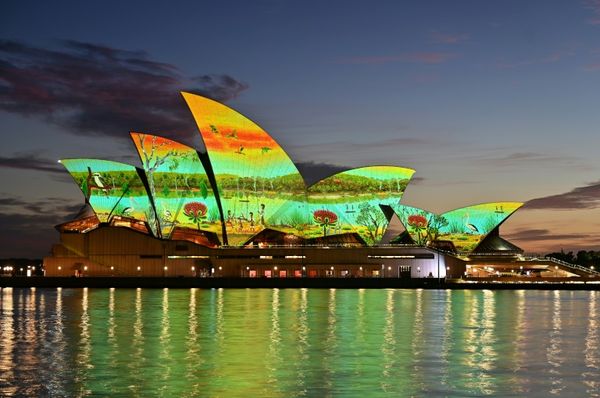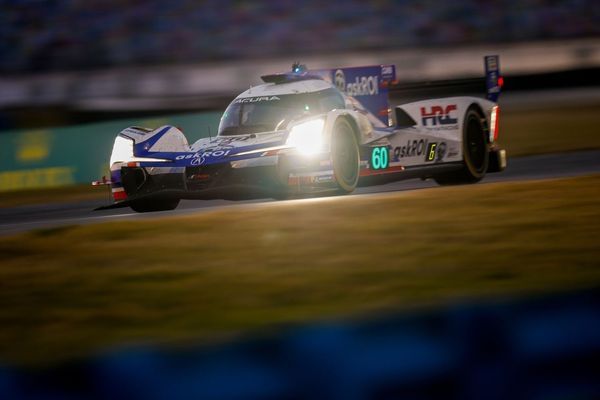TarraWarra Museum of Art's latest exhibition begins with a room that Wurundjeri curator Stacie Piper calls the "Welcome to Country". The songs of Djirri Djirri, a Wurundjeri women's dance group formed in 2013 by Mandy Nicholson and her family members, soar through the south gallery.
As the viewer listens to Woiwurrung language, they are invited to view the paintings of Wurundjeri man William Barak done at Coranderrk station between 1880 and 1900, some of which are embedded on a supersized photograph of a scene from Coranderrk station in 1890.
This depiction of working life on the station (on loan from the State Library of Victoria), wallpapers the western wall of the gallery, mirroring a film work of the Djirri Djirris dancing on country nearby the gallery.
It is a scene Piper wanted included in the exhibition, because while life on the station was a complex experience of colonial violence for the ancestors who resided there, it also represents a place of family connection and political empowerment which she wanted to honour.
The exhibition is WILAM BIIK, the second major show to be presented as part of the Yalingwa program: a partnership between the Victorian Government, the Australian Centre for Contemporary Art (ACCA) and TarraWarra Museum of Art designed to support the development of outstanding contemporary Indigenous art and curatorial practice.
WILAM BIIK, named after the Woiwurrung expression for "home country", celebrates the culture of the traditional custodians on whose land TarraWarra Museum of Art sits — from the works shown, to the way they are presented.
Some of Barak's paintings, along with his personal tools and possessions, have been exhibited previously, including in galleries in Victoria; however, Piper notes that this is likely the first time the works have been displayed on country, with Wurundjeri people in full control of the curatorial process.
The south gallery also contains a group of tools, adornments and paintings belonging to Wurundjeri ancestors and other First Peoples from the south-east region, on loan from institutions like Museums Victoria, the Koorie Heritage Trust, the Art Gallery of Ballarat, Queensland Art Gallery, and an anonymous private collection.
These items — including parrying shields, digging sticks, headbands, river reed necklaces, grinding stones, and emu feather skirts — are exhibited alongside works from the living community. Contemporary woven eel traps, jewellery, woven mats and digging sticks made by the members of Djirri Djirri, in addition to Kim Wandin (Wurundjeri) and Joyce Moate (Taungurung), are placed among the ancestral items.
The presence of the ancestors through the whole exhibition makes a viewer feel as though they are walking around in a family home rather than an art gallery.
Nineteenth-century portraits of Wurundjeri leaders from Coranderrk — William Barak, Annie Borate, Robert Wandoon, and Jemima Burns Wandin Dunolly — are "wrapped in country": framed in reclaimed timber from native mountain ash and woven natural materials by Wurundjeri artist Kim Wandin.
Yorta Yorta woman Kimberley Moulton writes in the exhibition catalogue that encountering these images and items disrupts and displaces colonial time — "it is through the portals of the cultural materials of the old people that I travel".
As you walk around the gallery, seeing these images and possessions from the generations before creates a feeling that the ancestors are looking on.
Each of the personal items are dated and labelled with the Woiwurrung word "Liwik" (ancestor). This is important. In WILAM BIIK, ancestors are revered and honoured as artists who come from the community and belong to a community, rather than being acknowledged with an anonymous and objectified "unknown" label, as is common practice in museums around the world where ancestral items are held.
Museum protocols demand presenting the loaned items behind glass cases, but these pieces are, Piper tells me, supposed to be used and touched.
The headbands, emu feather skirts and river reed necklaces are a part of everyday life for the Wurundjeri women in Djirri Djirri dance group (of which Piper is one).
"Having the contemporary works on display out here, rather than in the glass cases, shows that they are current," says Piper.
"It was hard to choose which ones we would display here because we use them all the time. They are country, they are made from the trees and the grass."
This deliberate choice to represent Wurundjeri tools and adornments as contemporary objects is one of the ways that WILAM BIIK shows a necessary breakdown of the authority of museums and other institutions to determine Aboriginal cultural practices.
This breakdown is made physical in Taungurung artist Steven Rhall's work Of the Earth — through the literal breaking down of one of the gallery walls.
"He really wanted to go through the wall," Piper explains.
"The whole thought process around it was about the geological history of country. Taungurung have lots of big granite boulders around their country. I encouraged Steven to work with the connection between the boulders and the stone tools on loan, because those boulders have a geological timeline and story on them, and many of them on Wurundjeri and Taungurung country have also been compromised by logging. They've coexisted for eons with the flora and fauna around them."
Reminders of the threatened skylines, water lines, forest lines which are shared by communities of the south-east confront the audience throughout the show.
The urgent task behind WILAM BIIK is to ask non-Indigenous people to consider their connection to country, inviting them into a sense of shared responsibility with traditional custodians.
Asking "How do we see Country? How do we listen to Country? How do we connect to Country?", the show's ten artists explore the lines of connection between many First Peoples of the south-east.
These connections expand from Wurundjeri country all the way to Barkandji country in the north, Yorta Yorta country, Ngarrandjeri country, Gunnai/Kurnai country, and Trawlwoolway country.
Many of the show's artists are involved in active struggle against loss of the culturally vital ecosystems in the south-east.
An ongoing fight against logging involving members of Taungurung, Wurundjeri and Gunnai/Kurnai communities has continued during the pandemic, and — as shown in Rhall's stunning photography of part of the threatened area on Taungurung country — the grief around this is close to the surface in WILAM BIIK.
Piper says: "They're still out there daily, despite the pandemic, destroying biodiversity. They clear large areas of country and incinerate it afterwards. The fires reach several meters underground."
WILAM BIIK is also a celebratory meeting of the peoples of the south-east who assert that they are, rather than divided by border lines, connected through ancient water lines, song lines, and forest lines.
In the work Six Layers of Country, Djirri Djirri dancers sing about the soil, the land, the water, the air, the sky, and the animals that reside within country-elements that connect First Peoples of the region.
Trawlwoolway and Tyereelore artist Nannette Shaw's handmade kelp water carriers articulate her concern for the shrinking of the underwater kelp forests of the bass strait, while also illustrating her own understanding of the water line of ocean which connects south-east Victoria to Tasmania, where a land bridge once connected the island to the mainland.
Dr. Paola Balla, a Wemba Wemba and Gunditjmara artist, uses bush dyed organza silks to adorn a tent, in a work that aims "to show what healing spaces could feel like, where restorative aesthetics, cultural acts and sovereign art weave across time," she explains.
Barkindji man Kent Morris represents sky country and the Creation story of two sisters, the kiinki (corellas), who "ascended to the stars".
Piper emphasises that through fostering connection to the place that they live, WILAM BIIK asks viewers to take their responsibility towards country seriously.
"We hope a bigger conversation can grow out of the show. The integrity of country still isn't considered."
WILAM BIIK runs October 30-November 21 at TarraWarra Museum of Art, Wurundjeri Country, Healesville, Victoria.







